
 American Honda’s head of sales planning and logistics, Chuck Kendig, reveals the philosophy behind his approach to managing the carmaker’s outbound flows and describes how the department operates to cope with changing model demand
American Honda’s head of sales planning and logistics, Chuck Kendig, reveals the philosophy behind his approach to managing the carmaker’s outbound flows and describes how the department operates to cope with changing model demand
Since April 2015, when Chuck Kendig inherited vehicle distribution for American Honda – a multi-faceted role across production, sales and logistics – he has steered its outbound supply chain during a time of limited inventory of certain models and during important ramp-ups across North America.
The US market has shifted faster to SUV and truck sales than Honda and Acura forecasted, while the brands’ model line-up and production mix are weighted towards slower-selling cars and sedans. In response, American Honda is changing output and import flows. For logistics, meanwhile, the carmaker had been in the midst of complex modal shifts, as well as dealing with transport quality issues for the growing number of vehicles moving in and out of Mexico.
In this story...
On the surface, that might seem a disadvantage for Kendig, who has spent most of his 25-year career with Honda in marketing, dealer-facing sales or service areas, with virtually no experience in logistics. “I had been dealing with everything after a car arrived at a dealership and now I had to face this world of trucking, rail, processing and border crossing. I’ve spent a lot of time with my head in the ditch trying to figure it out,” he admits.
Meanwhile, Honda’s seasoned experts and providers have helped keep things moving and the carmaker has barely missed a beat in its distribution. Despite its product mix, Honda has grown ahead of the market in 2016, including as one of the few carmakers to register growth for cars. It has done so with a high fulfilment rate on dealer orders, meeting requests despite limited supply of products such as the Acura MDX SUV, Honda CR-V crossover, Pilot SUV or Ridgeline truck.
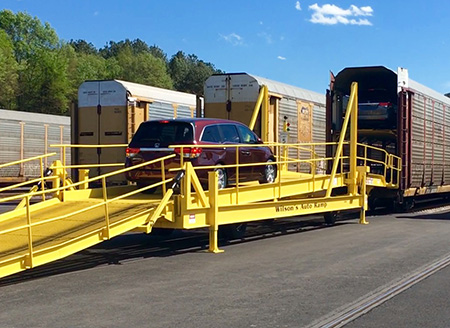 Honda has consolidated rail services in the eastern US, developing a truck shuttle to a new rail yard in Talladega, Alabama from its plant in Lincoln
Honda has consolidated rail services in the eastern US, developing a truck shuttle to a new rail yard in Talladega, Alabama from its plant in LincolnIn logistics, Honda has also implemented important changes. It consolidated rail services in the eastern US, which involved developing a truck shuttle to a new rail yard in Talladega, Alabama from Honda’s plant in Lincoln. In response to rising damage rates for rail in Mexico, pressure from industry has prompted the Mexican government to go so far as deploying federal troops to maintain security; from Honda’s side, improvements with providers have been explored and one alternative route has been put in place.
Honda has furthermore achieved one of the industry’s highest ratios of dealers accepting extended-hour deliveries, to the benefit of trucking turnaround times and traffic. It is also rolling out electronic proof of delivery (ePOD) across carriers and dealers.
Kendig, not one to take credit that isn’t his, praises executives who have worked on these and other projects. Nick Digeralamo, manager of sales and logistics planning, has led many network improvements – including the eastern rail consolidation – and is spearheading Honda’s ePOD initiative. Scott Crail, senior manager of operations, is deeply involved in improving transport and vehicle handling at plants and railheads, where Honda’s fast turnaround and low inventory strategy often leaves it in credit with railways. Tosh Muraviov, manager of port and field operations, oversees a national logistics field force and has been instrumental in convincing dealers to extend delivery hours. Muraviov and his team have also played key roles in the success of various product launches, as well as in reducing vandalism within Mexico for product travelling on rail to ports and the US border interchange.
Kendig also credits his predecessor, Dennis Manns, for leading innovative projects, including Honda’s multimodal export strategy from Mexico. Manns left Honda last year for processing and facilities provider, Road & Rail Services.
Kendig might be inexperienced in logistics, but his dealer and service roles have helped him to understand the retail point of view better than most in the sector. He also appreciates the importance of strong relations across Honda departments and with partners, something he now views to be as critical to improving logistics as it is for sales and marketing.
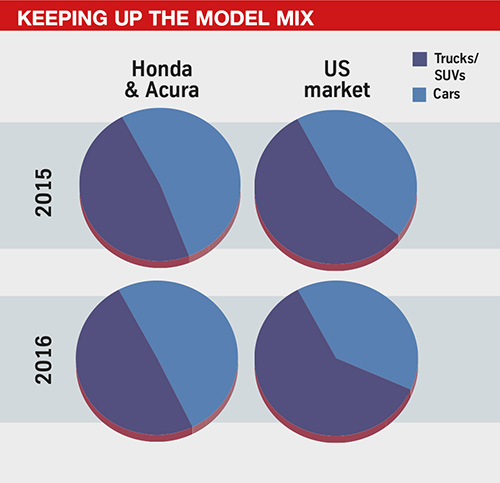 Over the last 18 months, Kendig has also clearly enjoyed getting to know the leaders who take charge of Honda’s logistics providers.
Over the last 18 months, Kendig has also clearly enjoyed getting to know the leaders who take charge of Honda’s logistics providers.
“The vehicle logistics industry is full of great people, from the professionals loading railcars to our over-the-road truck drivers, up to the top executives of logistics firms. Understanding each of them is really key to how we succeed as a company,” he says.
Kendig praises the entrepreneurial leaders at Honda’s trucking providers, such as Dave Floyd, president of Professional Auto Transport, and Leo Doire, president of Virginia Transportation, who played a major role in the success of Honda’s Talladega operation.
He also compliments the leaders of class one railways, such as Matt Rose and Carl Ice at BNSF, Clarence Gooden at CSX, José Zozaya at Kansas City Southern de Mexico (KCSM), and Fernando Lopez Guerra from Ferromex (FXE), among others.
[sta_anchor id="1"]“Our rail service has gotten better, faster and more fluid,” he says. “Our freight has benefitted from a modulation in other sectors, like energy and coal. However, even in crunch times companies like CSX and BNSF have been disproportionally responsive to our needs – they are true long-term partners.”
Binding the way togetherSuch appreciation of colleagues and logistics providers is not an exercise in name-dropping for Kendig, but part of his approach to business relations – something he thinks suppliers should also think carefully about with Honda.
For example, getting important projects and strategies approved by the company’s top management often requires what the Japanese call nemawashi, which translates as ‘root-binding’ – a subtle, careful approach to building consensus. This process includes informal and formal meetings, and pre-meetings to build trust and understanding, and to give indications about the direction and benefits of a plan or idea before making an official proposal.
“You won’t get very far if you don’t understand how our top management works,” says Kendig. “That’s important for logistics projects as well.”
Building consensus within the company and with providers will be important as Kendig sets his own strategy for the years ahead based on the market, consumer behaviour and technological drivers of Honda’s business.
"The vehicle logistics industry is full of great people, from the professionals loading railcars to our over-the-road truck drivers, up to the top executives of logistics firms. Understanding each of them is really key to how we succeed as a company." - Chuck Kendig, American Honda
For example, irrespective of future questions around the North American Free Trade Agreement (Nafta) under the incoming administration of Donald Trump, improving logistics quality in Mexico is a priority. Honda is working with railways and Mexican officials on the issue – as well as short-sea shipping lines for alternative routes.
As Kendig’s role involves production and sales planning, he must often bridge the gaps between customer demands and the supply chain’s messy reality. In the age of Uber and Amazon, when tracking products is increasingly a given, dealers want more clarity over vehicle supply, and Kendig is investigating how Honda can improve the transparency and accuracy of deliveries, and present it in a more dynamic, automated platform.
[sta_anchor id="2"]“That will be a ‘scoping’ project for the next fiscal year, as we will investigate how we can improve visibility, and feed that into our ETA [estimated time of arrival] system, in a way that leverages the data already out there and is not very expensive,” says Kendig.
A time of changeIncreasing partnerships and visibility will be important for another reckoning Kendig is preparing his team and suppliers to face: a stagnant or even declining US sales market, in which logistics costs need to be cut.
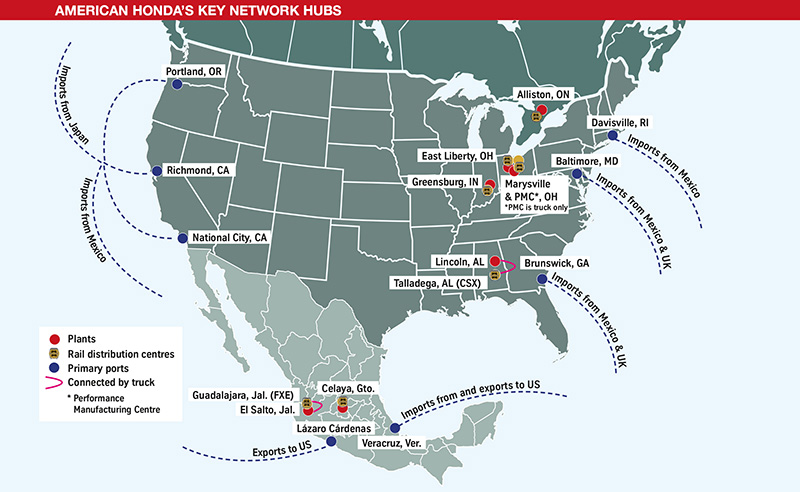 American Honda's key network hubs – click to enlarge
American Honda's key network hubs – click to enlargeThough there has rarely been a time when forecasts seemed more unpredictable, Honda is working off a consensus of analysts that sees the US market levelling off or gently falling to around 17m units over the coming years, down from a record 17.4m in 2015 and similar volume in 2016.
Honda expects to grow within this market, which will put more pressure on its model availability. In the US, the carmaker’s current sales split between larger vehicles and cars is around 50:50, compared to a market Honda now estimates will finish 2016 at 62:38 in favour of light trucks and SUVs. “We couldn’t shift production capacities to light trucks as swiftly as we would have liked,” he says.
Honda is thus reordering aspects of its production and import network. It will shift some Acura MDX output from Lincoln to its plant in East Liberty, Ohio, so Alabama can build more SUVs and pickups; it is also moving production of the new CR-V to Greensburg, Indiana, from its plant in El Salto, Mexico, (CR-V is also produced in East Liberty and Alliston, Canada). In El Salto, Honda is adding the HR-V subcompact SUV, whose primary production is in Celaya, Mexico.
With Honda’s North American capacity close to full, it will first tap other regions’ capacities, including Europe and Japan, which in turn will help balance the logistics networks and provide greater flows through US ports.
“We have a significant stranded capacity in these ports and we’d love to put it to use,” says Kendig.
The rise in imports could also help Honda make better use of its 390 Auto-Max railcars, a type of adjustable, high-capacity wagon the carmaker acquired in 2008. At the time, the fleet was used to move imported vehicles from the west coast to the Midwest, where they were reloaded at Honda plants for return journeys. However, with the decline in imports, the Auto-Max fleet has been redeployed mainly for rail flows in Mexico, where they sometimes get stuck in loops serving other carmakers, according to Kendig.
Making better use of port and railcar capacity would also address a rising trend in logistics cost per unit over the past seven years, which has grown above inflation even as fuel costs declined, according to Kendig.
 Kendig: Looking for mutual gains and benefits with supply chain partners
Kendig: Looking for mutual gains and benefits with supply chain partnersSome increases have been for strategic purposes, such as more flexible transport to get cars to market during the winter. However, Kendig suggests Honda will need to take some tough decisions. He is not, for example, a fan of ‘escalators’ that increase contract costs without adding value. He also suspects some trucking and rail flows could be rationalised.
However, he hopes to make such changes in coordination with logistics providers, rather than in opposition.
“We do quarterly reviews with most of our business partners, and I want them to give us their ideas about how we can be more efficient so that we can see a levelling out, or even a reduction, of this rising cost trend,” says Kendig.
[sta_anchor id="3"]“Everyone has to make money and I’m not looking for ‘we win, you lose’ scenarios. We want to see mutual gains and benefits. Since our profits are not rising, this must be a priority.”
A Talladega tangoA number of projects involving changes to rail and trucking may be instructive in understanding where Kendig will look to reduce logistics costs. With 80% of vehicles moving by rail, Honda has one of North America’s highest ratios of rail usage. However, it has recently demonstrated a willingness to increase truck use or distances to be more flexible.
Such an approach was evident in Honda’s rail consolidation in the east, where it switched from using Norfolk Southern and CSX to just CSX. The change involved shifting railheads and developing the Talladega yard especially for Honda. Car carrier Virginia Transportation moves 1,100-1,400 vehicles per day the 19 miles (30km) between the plant in Lincoln and the yard. To make this shift sustainable, Honda and Virginia are using CNG-powered trucks.
Although production from Lincoln used to load directly onto rail at the plant’s Alabama Distribution Centre, converting to a trucking operation has lowered total costs. That is because the new configuration reduces overall delivery times, as the CSX routes are more efficient from Talladega than they were from Lincoln. The carmaker also hasn’t been short of a single railcar since January 2016, eliminating the costs of finding replacement trucking to make up for railcar shortages.
“We have a significant improvement in speed-to-market for our eastern network thanks to this change,” says Kendig. “It significantly reduced our costs and because of the use of CNG trucks – which Virginia helped to design – we did it an environmentally friendly way.”
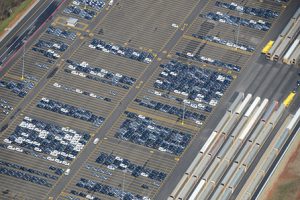 The Talladega distribution centre, owned by CSX, has helped Honda to reduce overall transit time thanks to more direct rail routes
The Talladega distribution centre, owned by CSX, has helped Honda to reduce overall transit time thanks to more direct rail routesHonda’s willingness to increase trucking is reflected elsewhere. Following the winter woes that crippled the rail network in 2014-2015, Kendig’s team put into place a ‘winter mitigation’ strategy, which includes expanded trucking routes to dealers or to alternative railheads, prioritising getting cars to market over inventory build-up.
“By increasing trucking distances from our factories and shuttling to different rail-loading facilities, we are able to catch more railcars wherever we can,” says Kendig. “That allows us to avoid trucking vehicles somewhere to store them, only to drive back to dig them out of the snow a month later.”
Both of these projects demonstrate that Honda is willing to be flexible and make unconventional decisions. Giving up the use of rail access at its Lincoln plant in exchange for a truck shuttle suggests nothing should be taken for granted, says Kendig. That has already proved valuable in a number of negotiations and plans made with other logistics providers.
The use of CNG trucks at Talladega may also be the first of more alternative transport and fuel options. Several trucking companies have shown interest and Kendig expects several to introduce CNG-powered trucks along certain routes in 2017.
Greener transport options are increasing for other modes as well. Tote Marine, which runs shipping services from the US south-east to Puerto Rico, and the north-west to Alaska, is converting its fleet to liquefied natural gas (LNG). Tote ships started refuelling in the south-east in 2016 and will soon start on its Seattle to Alaska routes, which serve Honda.
The Florida East Coast Railway (FEC), meanwhile, a short-line rail provider, has also recently started using LNG locomotives. “That’s a dynamite operation and will hopefully lead to more examples,” says Kendig.
[sta_anchor id="4"]Such innovations will be significant to Honda for cost and emission reduction. “We are not putting pressure on our providers yet, but determining how green our suppliers are will be an important criterion for us in the future,” he says.
No time to lose in MexicoFlows in and out of Mexico represent perhaps the biggest opportunity to improve logistics cost and quality. According to AMIA, the Mexican automotive association, Honda is set to build around 260,000 units in 2016 in Mexico, of which more than 200,000 will be exported – including 170,000 to the US and Canada. Honda also ships about 60,000 vehicles to Mexico each year from the US or Canada.
With Honda adding the HR-V to El Salto, replacing the CR-V built there mostly for the Mexican market, the carmaker is likely to increase exports to the US and move higher numbers of the CR-V southbound to Mexico.
"Our rail service has gotten better, faster and more fluid. Our freight has benefitted from a modulation in other sectors, like energy and coal. However, even in crunch times companies like CSX and BNSF have been disproportionally responsive to our needs – they are true long-term partners." - Chuck Kendig, American Honda
Of course Honda, along with other manufacturers, will pay careful attention to what the new US administration will do with Nafta, after Donald Trump campaigned to change or dismantle it, including imposing steep tariffs on imports from Mexico. Honda’s chief executive officer, Takahiro Hachigo, has said the company will stick to its current strategy in North America, however, he acknowledged the industry would have to wait and see what happens.
Changes to Nafta may influence future investment decisions; Honda, for example, has plenty of space to expand its plant in Celaya. However, the OEM cannot afford to wait for volume or regulation changes before improving its vehicle logistics in Mexico. While production stability and quality have improved, there are issues with transport-related damage, which in Mexico is significantly higher than Honda’s US damage rates.
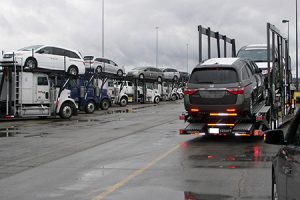 Transferring some finished vehicles from rail to road has boosted speed-to-market and freed up railcars
Transferring some finished vehicles from rail to road has boosted speed-to-market and freed up railcarsThe damage is mostly from vandalism or theft on rail transport, especially when moving through the central Bajío region, where delays along routes leave vehicles particularly vulnerable.
“Little of our damage is dings or scratches that result from handling or transport issues,” says Kendig. “The issue is mainly security.”
Honda uses a multimodal strategy for Mexican exports northbound, partly to reduce risk on any single route. Since the end of 2013, when serial production in Celaya began, vehicles have moved by rail up the middle of the country to the US and Canada, as well as by rail both to the east coast port of Veracruz and to the west coast port of Lázaro Cárdenas, for shipping to the US east and west coast ports.
From El Salto, vehicles are mainly trucked to a railhead in Guadalajara, where they move by rail over the border at El Paso, Texas to serve the ‘Sunbelt states’, which stretch from southern California across the southern half of the country to the east coast.
Most of the flows are effective. Kendig praises KCSM’s service to Lázaro Cárdenas, as well as most of the routes it manages north- and southbound. “KCSM’s security apparatus is fantastic,” he says.
The route to Veracruz, operated by FXE, also works very well. “FXE has really upped the game by implementing a unit train policy, with which we’ve been very impressed,” says Kendig. A unit train (or ‘block train’) carries a single commodity between origin and destination.
“In all other areas FXE is working hard to ensure secure, on-time transits for our freight and the situation is definitely improving,” adds Kendig. “Even though recently helped by the presence of federal troops, it’s hard to understate the level of commitment FXE has shown to this cause – just remarkable.”
While Honda sees the situation improving, it has been planning alternative strategies, such as using more short-sea shipping where possible. However, the carmaker has limited room to switch more flows out of Mexico from rail to short sea. Already around 50% of its US and Canada-bound volume is shipped from Veracruz, with another 20% from Lázaro Cárdenas, and just 30% moving purely by rail.
The delivery time for short-sea is also often longer than rail, while Honda does not yet receive the frequency of service it would prefer, which can create unwanted dwell in the ports. From Veracruz, Mitsui OSK Lines (MOL) calls every ten days, but Honda would prefer a weekly service. From Lázaro Cárdenas, the MOL service is part of a wider loop with Europe that arrives at the Mexican port every three weeks, whereas Honda would prefer a twice-monthly call.
While diverting more flows to short-sea would increase volume for shipping, Honda’s vehicles alone wouldn’t warrant a big increase in service. “We are pushing everywhere we can to smooth flows, but they are by nature, at least presently, a bit sporadic, so MOL is understandably cautious to add additional capacity," says Kendig.
Kendig is realistic as well; there is some over-capacity in ocean shipping and companies need to be smart to remain profitable. He also points to efforts that MOL has made to make sure Honda volume keeps flowing.
“If our ports really start to load up, MOL is very good at keeping our dwell reasonable through partnerships,” he says. “MOL is a long-time partner of Honda and a real ‘stand-out’. They’ve stuck with us through the ups and downs of start-up operations in Celaya and have never wavered. They are a critical link in our strategy and we appreciate them greatly.”
With relatively infrequent shipping service, any rail issue en route to ports could result in long delays if a sailing is missed. For that reason, Honda’s export logistics team – which is responsible for shipping vehicles beyond North America – now moves vehicles to ports by road rather than rail. For these flows, which are smaller than US-bound exports and often headed to destinations with low frequency, missing a ship can mean delays of a month or more.
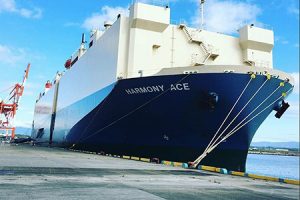 Since the end of 2013 when serial production in Celaya began, vehicles have moved by rail up the middle of the country to the US and Canada, as well as by rail both to the east coast port of Veracruz and to the west coast port of Lázaro Cárdenas
Since the end of 2013 when serial production in Celaya began, vehicles have moved by rail up the middle of the country to the US and Canada, as well as by rail both to the east coast port of Veracruz and to the west coast port of Lázaro CárdenasPort capacity from Mexico is also limited. Veracruz is crowded, with plans to expand ro-ro facilities delayed, while there aren’t rail-served alternatives on the east coast. The west coast is less of an issue, where Honda uses Amports’ processing facility in Lázaro; although it has a limited concession, it has served the carmaker well. SSA Marine, meanwhile, is building a specialised ro-ro terminal at the port.
[sta_anchor id="5"]Honda has also investigated other ports on the west coast that are served by FXE. “There are some good options with professional operations and capacity of which we, and I’m sure others, are increasingly aware,” says Kendig.
Light at the end of the rail tunnelHowever, having sustainable rail options is strategically important for Mexico’s automotive industry. The issue has become so prominent that carmakers’ chief executives sent a letter requesting help to Mexico’s president, Enrique Peña Nieto. The message seemed to get through: this past autumn the government started stationing federal troops along key railway lines, monitoring security and preventing people from boarding freight trains when they stop.
“The result has been phenomenal, with a dramatic reduction in incidents,” says Kendig.
Maintaining an army presence in the region could be difficult, especially if its purpose is to protect trade that may become the subject of dispute with Washington. However, the measures may provide an effective transition as the railways continue their work on both the infrastructure and operational aspects related to providing swift and secure transits.
Completing delayed infrastructure projects may also address the bottlenecks that invite theft and vandalism. In Celaya, for example, a major bypass that was supposed to move a busy interchange away from the city centre was supposed to be finished in 2013, before Honda’s plant opened. But land disputes and funding issues, including a reduction in the federal budget, have delayed completion.
 Mexico’s military response to security issues on rail transport has had a dramatic positive effect but the presence of federal troops is not a long-term solution
Mexico’s military response to security issues on rail transport has had a dramatic positive effect but the presence of federal troops is not a long-term solutionHowever, the Mexican transport ministry has said the project is a priority and wants to finish it by the end of 2017. “While not a party to or privy to these negotiations, we’re certain that all parties are establishing the frameworks which will allow the completion of the Celaya by-pass and dual access to the Honda plant by the end of 2017,“ says Kendig.
With the Mexican government engaged, and work set to restart on interchanges, Kendig is hopeful the rail situation will improve. “We see light at the end of the tunnel,” he says.
The better to see youFor Kendig, improving visibility in the order-to-delivery cycle will be a key platform for meeting dealer needs and potentially reducing costs.
Honda is already no laggard in this area. It has an in-house vehicle tracking and reporting system, VTR2, which records vehicle locations based on scans at plants, distribution centres and other points. The system uses this information, combined with historic data, to forecast delivery times based on each transport leg.
Thanks to the system, Honda can provide an ETA to dealers once a vehicle is assigned to it, which is then updated at each milestone. Dealers can see the last place a vehicle has been scanned, including the latest location of rail flows based on scans along the tracks.
The ETA accuracy is at a reasonable level. According to Honda measurements, the first estimates dealers receive are 85% accurate within three days of delivery, with the date more precise as vehicles move through the supply chain.
However, there are gaps in the information. Transport providers or processors often have advanced systems, but they don’t communicate with each other, leaving Honda to compile data in spreadsheets. Dealers therefore aren’t automatically notified about issues, such as missed sailings or damage.
“There are benefits to seeing a real-time image of what is happening, or to visualise why 1,500 cars might be sitting in one place,” Kendig says. “A railroad might send me a notice about a washout, but I would like a system that sends me a notification or warning instantly so I can identify problems before they get worse.”
The lack of integration is perhaps most evident in tracking vehicles from Mexico, where transit includes multiple handovers, and delivery can be up to 30 days for the entire short-sea routing, including rail to ports, shipping and trucking.
However, there are perils in having too much visibility. While dealers complain about inbound vehicles from Mexico, they are satisfied with the process from Japan, but these vehicles do not show up in VTR2 until they are about a day from shore, while from Mexico dealers see vehicles once they have been assigned.
"Those who pick up the phone and ‘tell’ railroads, trucking companies and ocean carriers, rather than ‘ask’ and seek to understand, don’t get very far." - Chuck Kendig, American Honda
“This means dealers see vehicles the whole way, including the sputtering nature of the transport chain with its clumsy interchanges, the ships we may or may not miss, the on-and-off rail or truck loading, all the hand-offs where something might go wrong,” says Kendig. “Dealers might feel differently if we just showed vehicles once they crossed the border and had been inspected.”
Nevertheless, Kendig sees benefits in visualising the supply chain and automating information across it. Honda is updating to its VTR2 system and tracking processes, including analysing each transport lane, to better forecast delivery times and variation, from how quickly railways get vehicles grounded to turnaround times at distribution centres.
[sta_anchor id="6"]A significant improvement may come by simply presenting data already available in a user-friendly way – a ‘dashboard’ view where dealers, Honda executives and eventually even logistics providers could use it. Honda will explore the costs of such a system over the next year.
Not going it aloneNew technologies could play a bigger role in reducing logistics costs and increasing visibility in the coming years or decades. In future, options such as RFID could automate vehicle scans, the telematics and connectivity built into vehicles could provide precise locations and status of vehicles, while eventually trucks and vehicles may drive autonomously out of the plant and through the distribution centres.
An ‘Uberisation’ of freight may also impact vehicle logistics, where technology might be used to match carriers to volume. Kendig sees scope to use the data already being collected by multiple sources as a potential bridge to such advances.
“One challenge for our crew is to arrange our network to have more truckers doing triangle routes, reducing empty miles and therefore emissions and expense,” he says.
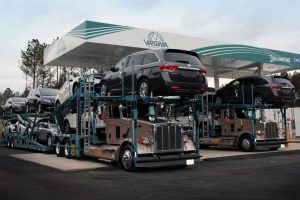 Kendig says one target is to arrange the network so that more trucks can carry out triangular routes, reducing empty miles, emissions and expense
Kendig says one target is to arrange the network so that more trucks can carry out triangular routes, reducing empty miles, emissions and expenseKendig does not see the future only in terms of cutting cost; he also doesn’t want to compromise on quality or speed, as all three have a strategic priority in Honda’s planning and operations. Honda’s ‘winter mitigation’ strategy is one example.
“For instance, during winter we may have to flex a bit on cost in order to keep product flowing to the market,” says Kendig. “In this sense, speed becomes relatively more important. Missing sales opportunities, should our dealers run low on product due to winter slowdown in the logistics network, would mean we lose both current sales opportunities and often could mean special programmes to sell down inventory bubbles created by the slowdown.”
Likewise, increasing vehicle visibility may not carry an identifiable return on investment, but Honda recognises its importance as a service to partners, including dealers, logistics providers and different Honda departments.
Ultimately, Kendig understands that the carmaker can’t improve visibility, network speed, quality and cost on its own. To create the efficiencies and ‘win-wins’ he craves, Honda must understand its logistics providers’ strengths and challenges, and work closely with them.
“Those who pick up the phone and ‘tell’ railroads, trucking companies and ocean carriers, rather than ‘ask’ and seek to understand, don’t get very far,” he says. “Instead, the Honda way is to try understanding what our partners are up against and help them understand our goals.
Kendig points to Honda’s ‘Three Realities Principle’, which is firstly ‘go to the actual place’; secondly, ‘know the actual situation’; and lastly, ‘be realistic’ about what can practically be done about the situation.
[sta_anchor id="7"]“Together with our partners we tend to find ‘win-win’ solutions which are smart, sustainable and profitable for everyone involved,” Kendig says. “When we interact in this way, we find our partnerships deepen and strengthen to mutual benefit.”
 Some 80% of Honda dealerships now accept some form of out-of-hours deliveries, along with 77% of Acura retailers
Some 80% of Honda dealerships now accept some form of out-of-hours deliveries, along with 77% of Acura retailersWhile Honda has ambitions to improve total order visibility, it has already been quietly advancing in other areas of delivery. Though not among the first carmakers in the US to mandate that its dealers and carriers use electronic proof of delivery (ePOD) to automate final handover verification, over the past year it has made significant progress. Manager of sales and logistics planning, Nick Digeralamo, is leading a project with the goal of having 100% ePOD by the end of 2017.
Electronic proof of delivery not only reduces paper and bureaucracy, but it can improve Honda’s overall reporting of delivery times, damage and claims reporting. For example, trucking firms sometimes wait several days (or longer) after the actual handover to confirm deliveries, says Chuck Kendig, perhaps batching them together. That can distort Honda’s total delivery data. But with a geofenced, timestamp confirmation and photos, processing can be instant.
Along with ePOD, Honda has done well to convince dealers to extend hours of deliveries, including late evenings or weekends. According to Kendig, 80% of Honda dealerships in the US and 77% of Acura ones now allow a form of extended delivery hours.
Based partly on service parts, which arrive at dealerships overnight to lockboxes in parts departments, drivers have access to a dealer yard to park vehicles overnight. The dealer typically has 48 business hours to report any damages or discrepancies.
Such deliveries bring a multitude of benefits. Carriers can reduce hours, as drivers avoid waiting overnight or an entire weekend to drop off shipments. With truckers able to deliver at night, they can navigate urban areas at off-peak traffic times, saving time and fuel costs from idling in traffic.
Such deliveries also free up dealer space during the day; trucks don’t block service bays or the flow of customers coming in and out of lots. According to Kendig, such deliveries result in lower costs and improved service without notable increase in damages or security issues.
Some dealers are reluctant to extend their hours, depending on their location and willingness to leave vehicles unattended. Others, meanwhile, have reported a somewhat surprising reason for resisting: customers no longer see new cars arriving.
[sta_anchor id="8"]“Some dealers tell us that they miss the excitement of a truck full of shiny new vehicles showing up, and the enthusiasm that can bring both to sales consultants and to retail customers,” says Kendig. “But most dealers don’t weigh that too heavily against the efficiencies they see.”
 As assistant vice-president for sales and production planning, logistics, Charles (Chuck) Kendig has three jobs in one. Perhaps more, as his role also combines aspects of central management, based at American Honda’s headquarters in Torrance, California, with field operations across plants and sales areas. His department furthermore manages some operations for Canada and Mexico, with dotted-line responsibility for regional logistics.
As assistant vice-president for sales and production planning, logistics, Charles (Chuck) Kendig has three jobs in one. Perhaps more, as his role also combines aspects of central management, based at American Honda’s headquarters in Torrance, California, with field operations across plants and sales areas. His department furthermore manages some operations for Canada and Mexico, with dotted-line responsibility for regional logistics.
To understand the scope of Kendig’s department, follow the pattern of Honda’s order planning through to distribution.
It starts with a seihan, or planning group, which determines manufacturing across Honda’s eight North American plants. Together with the sales organisation, the group forecasts down to model and trim level, which is then matched against factories’ ability to supply, based on their capacity.
That production plan feeds into Honda’s allocation system for the US, which was updated shortly before Kendig took over the department in April 2015. The system suggests a monthly order batch for each dealer based on their sales history, seasonality, product launches and campaigns. Dealers can accept these recommendations or make changes and modifications, depending on demand and real customer orders.
“The new system we use, which was built in-house with external help, gives dealers more input to help us understand true demand and make production more responsive,” says Kendig.
“It is not a ‘built-to-order’ system, but it is more sensitive to market demand, and we can adjust various market sensitivities based on the type of vehicle and its sales profile,” he adds. “It’s a very sophisticated system which took years and a lot of dealer input to develop.”
Allocation for products built in Mexico and Canada destined for the US are included, while each country also has its own allocation for domestic distribution.
Though Honda has struggled with capacity limits for truck and SUV models, its vehicle allocation has been stable. The carmaker currently has a fulfilment percentage rate in the high 90s against allocation plans across North America, including after dealer changes and requests.
After production planning and allocation comes logistics, which takes over once vehicles are built at North American factories or are close to shore for overseas imports. In Torrance, the logistics team coordinates operations from US plants and ports to US dealers, and works with teams in Canada and Mexico on moving vehicles to and from each respective country.
“For logistics, anything that crosses the border north or south [by land or sea] with the US is piggybacked onto one of our [American Honda] contracts since we have a massive purchasing volume,” says Kendig.
Along with the national leadership, there is local management for distribution centres around the US plants in Marysville, Ohio (which also covers the nearby East Liberty and PMC plant), Indiana and Alabama. There are also field managers and operational teams across three US regions, which interface with ports, railheads and trucking companies.
An export logistics team is separately responsible for all North American exports beyond North America, although contracts with processors and inland carriage are coordinated or combined with Honda’s regional flows where it makes sense.
While Canadian and Mexican plants have their own logistics management, these teams are working more closely with American Honda. A North American logistics coordination committee now meets regularly throughout the year, setting common metrics and standards. One example is that, after discovering they were not measuring the same thing, all three now report ground count and transit times uniformly. A yard management system used in the US, meanwhile, has been implemented in Mexico and Canada.
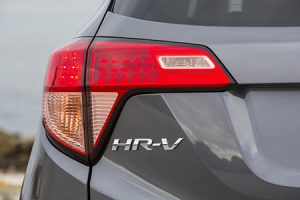 The hot-selling HR-V is already built in Celaya, while Honda’s other Mexican plant, in El Salto, will also build the product for export in 2017
The hot-selling HR-V is already built in Celaya, while Honda’s other Mexican plant, in El Salto, will also build the product for export in 2017The best laid plans…Having these functions and regional links in one department allows close collaboration in planning and transporting vehicle inventory. The teams meet daily and production planning is included in daily logistics calls that include distribution centre managers. Together they can respond quickly to changes in demand, or make sure that inventory is cleared quickly from plants following overtime work on weekends, or in the build-up to a launch.
However, Kendig suggests that the integration between production, distribution and logistics could be improved. Coordination is more ad hoc than process or system-led. There are also gaps between long-term production and network planning across the supply chain, for example, though Honda is working on new systems to address such issues.
The carmaker does not do load building or issue specific volume information about vehicles in the production pipeline to its logistics providers. It notifies carriers about delivery requirements once cars are produced and assigned at North American plants, or when ships with imported products are near shore.
“We’ve looked at doing pre-production load planning, but with very flexible production we find it best to wait until the unit is produced and assigned to a dealer,” says Kendig.
Honda’s fairly lean outbound logistics model also leaves little room to build loads in advance. Vehicles remain at plants or ports for a short period – typically less than 48 hours – before they are loaded onto rail or truck. The carmaker does little further customisation or accessories, leaving those changes to dealers.
“Unless we built a load lane for every one of our destinations, we couldn’t load much more efficiently,” says Kendig.

























![Global[1]](https://d3n5uof8vony13.cloudfront.net/Pictures/web/a/d/s/global1_726550.svgz)









